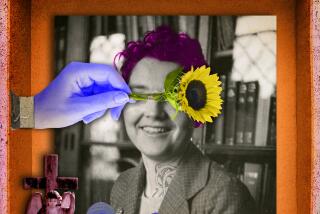For This They Died? : IN THE TIME OF THE BUTTERFLIES, <i> By Julia Alvarez (Algonquin Books: $21.95; 325 pp.)</i>
- Share via
Some days the world seems full of the kind of people who catch a butterfly, admire it, show it with pride to others, and then pull its wings off. Our families, our colleagues, our politicians--what should our response be? Horror and revulsion, of course, but then what? Punishment? A helpless shrug? Depression? How about pity? Is there any reason to pity the pitiless?
Julia Alvarez’s shimmering second novel, “In the Time of the Butterflies,” is based on the real story of the four Mirabal sisters of the Dominican Republic, known there as Las Mariposas , the butterflies. That was their code name in the underground opposition to dictator Rafael Leonidas Trujillo, and on Nov. 25, 1960, Trujillo agents murdered three of the sisters, the ones who had become national symbols of resistance. The fourth sister, Dede, survived, and Alvarez begins to tell their story in Dede’s tired, exasperated voice more than 30 years later.
She is dreading the arrival of yet another interviewing journalist. “Why, they inevitably ask in one form or another, why are you the one who survived?” Dede grumbles. It is the question all survivors ask themselves, and she parries it during the interview while she sorts through her memories of childhood, of family life, of love and birth and death, interwoven with the politics that defined the time of the butterflies. Unconsciously, Dede also summons the spirits of her sisters to tell their stories too.
It is part of Alvarez’s skill as a writer that the larger themes she takes on don’t obtrude too much through the voices of Dede and her sisters. Each of them becomes aware at different times of Trujillo’s reign of terror. Flighty Maria Teresa, the youngest, has to bury her treasured diary of Christmas treats and girlish crushes when a friend mentioned in it is arrested. Years later, her woman’s diary includes a drawing of how to make a Molotov cocktail, and pages from another become coded messages from prison. “May I never experience all that it is possible to get used to,” she writes.
Patria Mercedes, “the easiest, friendliest, simplest” in her devout Catholicism, feels invulnerable in her virtue to both Trujillo’s wrath and God’s when she yields to her sensual nature, “her humid eyes,” and marries. Then she loses her baby and her innocence. When the secret police tear up her house and burn it, driving her husband and her son into hiding, she nearly loses her sanity too, tearing up the grass: “ ‘I’ve been good! I’ve been good!’ Patria was screaming at the sky. The ground around her was bare, the grass lay in sad clumps at her side.”
And beautiful Minerva, in many ways the center of the novel, listens at her Catholic girls’ school to a fearful friend whose “story spilled out like blood from a wound.” Later Minerva binds her growing breasts so as not to suffer the fate of another classmate, a victim of Trujillo’s sexual favors. Trujillo spots her anyway, of course.
So do other men, and there is rivalry between Minerva and Dede over an intense, bespectacled young scholar--and secret revolutionary--named Lio, whose memory haunts Dede to this day.
The only suspense in this novel becomes the details of how the sisters died, and Dede’s question of why she alone survived. In the telling, though, the four sisters are defined more by what they did than who they were, their voices not always as distinctive as they might be. I found myself occasionally checking back to see which of them was speaking.
The actual killings, however, perhaps get rather more space than they require. Dede in the morgue afterward is very moving, and Maria Teresa’s earlier diary account of being tortured is gut-wrenching in its simplicity.
So what of Dede’s question? She admits early on that she distanced herself from her sisters’ underground work not because her husband disapproved, as she has told herself and them, but because “she was afraid, pure and simple.” Her husband gives her the only comfort on her sisters’ loss that makes any sense to her: “This is your martyrdom, Dede, to be alive without them.”
Finally, Dede looks around at the modern Dominican Republic, with its tourists and free trade zones and forgetful young. “We are now the playground of the Caribbean, who were once its killing fields,” she says, and trembles as she asks herself the most terrible question of all: “Was it for this, the sacrifice of the butterflies?”
Perhaps it is Patria of the renewing faith who has already given the answer. She watches the bloated Captain Pena waffle over her plea that her son be released from prison, and she prays: “ Soften his devil’s heart, oh Lord. And then, I said the difficult thing, For he, too, is one of your children. “She watches then, astonished, as “the devil I was so used to seeing disappeared, and for a moment . . . I saw an overgrown fat boy, ashamed of himself for kicking the cat and pulling the wings off butterflies.”
Ancient lessons, these, that need retelling in every age as new evasions rise against the old, hard truths: by compassion we rob our tormentors of their power. By living fully we survive our deaths; by surviving we enable memory. Writers of other eras meditated on these beads of justice and redemption through the realities of the Holocaust, or the Civil War, or of fire and flood or natural devastation or disease. Alvarez’s exploration of Las Mariposas and their families is a valuable and necessary addition to the small but growing collection of literary works launched by recent headlines out of Central America and the Caribbean. May their kind increase.
More to Read
Sign up for our Book Club newsletter
Get the latest news, events and more from the Los Angeles Times Book Club, and help us get L.A. reading and talking.
You may occasionally receive promotional content from the Los Angeles Times.










